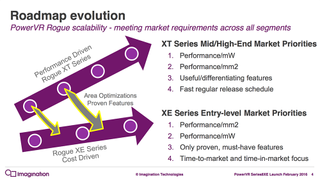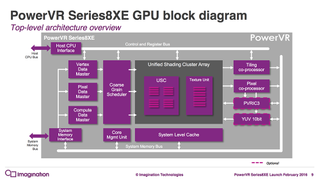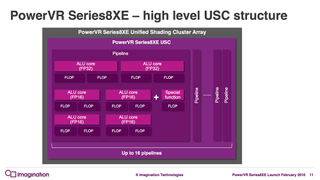Imagination's New Low-Power Series8XE GPU Doubles Fillrate
Imagination Technology announced a new GPU family at MWC 2016 that’s focused on low-cost smartphones, wearables, televisions, IoT devices, and other embedded applications where low-power usage is critical. The new PowerVR Series8XE is an iterative update to Series7XE that includes architectural enhancements to improve fillrate. It also adds support for the latest graphics APIs, including OpenGL ES 3.2 and Vulkan 1.0. Compared to the Series7XE, Imagination Technology said the Series8XE delivers either the same performance on a 25% smaller die, with a corresponding decrease in price, or higher performance on a chip of the same size.

Unlike high-end GPUs that focus on pixel shader performance for rich gaming, the Series8XE family focuses on pixel fillrate (texturing), which is more important for user interface rendering, smooth Web browsing, and light gaming. The new GPU family offers twice the fillrate at the same area as Series7XE, a significant but necessary gain as screen resolution increases in low-end devices.
High-end applications such as 3D gaming make extensive use of layering effects and multiple render targets. Because these operations may require multiple shader passes, 32-bit floating-point (FP32) values are necessary to retain precision. Low-end applications like those targeted by Series8XE, however, use more direct rendering methods that do not require high precision. Therefore, it makes sense to take advantage of the Rogue architecture’s dedicated FP16 ALUs to save power.

At a high level, a Series8XE USC looks just like a Series7XE or high-end Series7XT USC, with the same number of FP32 and FP16 ALU cores. However, there are architectural improvements within the ALUs to improve energy efficiency and throughput. Another feature that carries over from the Series7XT is the ability to co-issue SFU and ALU operations. Series8XE also includes a tessellation co-processor (no longer an optional component), making it surprisingly well-featured for a GPU targeting the low-end market.
Series8XE GPUs have a single USC with up to 16 pipelines. The texture unit scales with the number of pipelines in order to achieve the desired balance between shading performance and fillrate, without exceeding the area budget.

The PowerVR GE8200 and GE8300 are the first two GPUs announced in the Series8XE family and are capable of processing two and four pixels per clock, respectively. For comparison, the PowerVR GX6450 in the iPhone 6 processes eight pixels per clock, while the PowerVR GT7600 in the iPhone 6s processes 12 pixels per clock.
Series8XE also includes Imagination’s OmniShield GPU hardware virtualization, an especially important feature in the automotive space, where the same chip might be driving both the dashboard display and the infotainment system. Not only might these systems be running different operating systems (RTOS for the dashboard and Android for infotainment, for example), but the infotainment system is likely networked and needs to be isolated from the dashboard display for the sake of security.
Stay on the Cutting Edge
Join the experts who read Tom's Hardware for the inside track on enthusiast PC tech news — and have for over 25 years. We'll send breaking news and in-depth reviews of CPUs, GPUs, AI, maker hardware and more straight to your inbox.
While Series8XE is an iterative design with improved fillrate, power efficiency, and updated graphics API support, the high-performance Series8XT, which should be announced later this year, will bring more significant architectural changes.
Matt Humrick is the Mobile Editor at Tom's Hardware. Contact him at mhumrick@tomshardware.com and follow him on Twitter @digitalOut_net. Follow us @tomshardware, on Facebook and on Google+.
Most Popular




